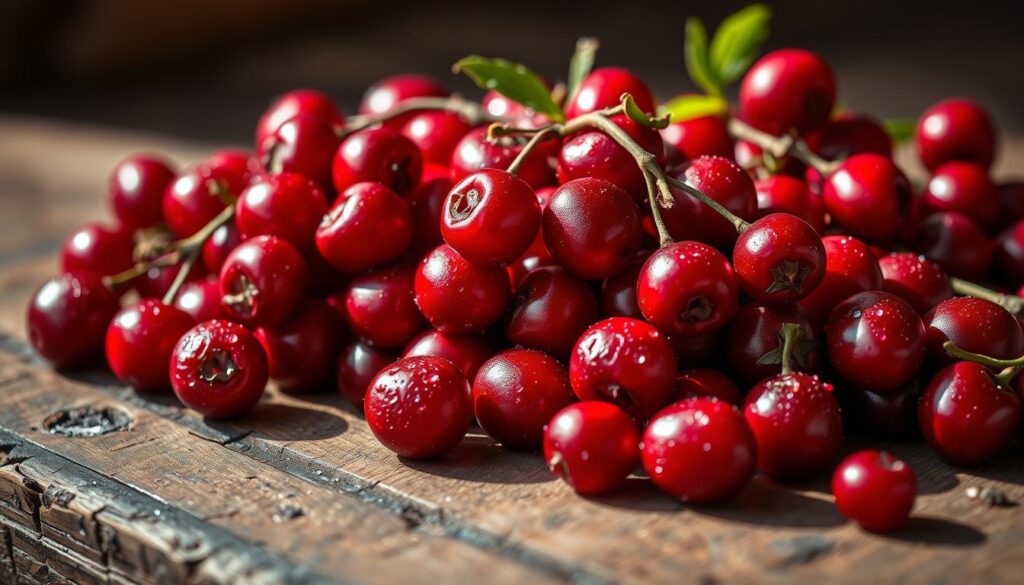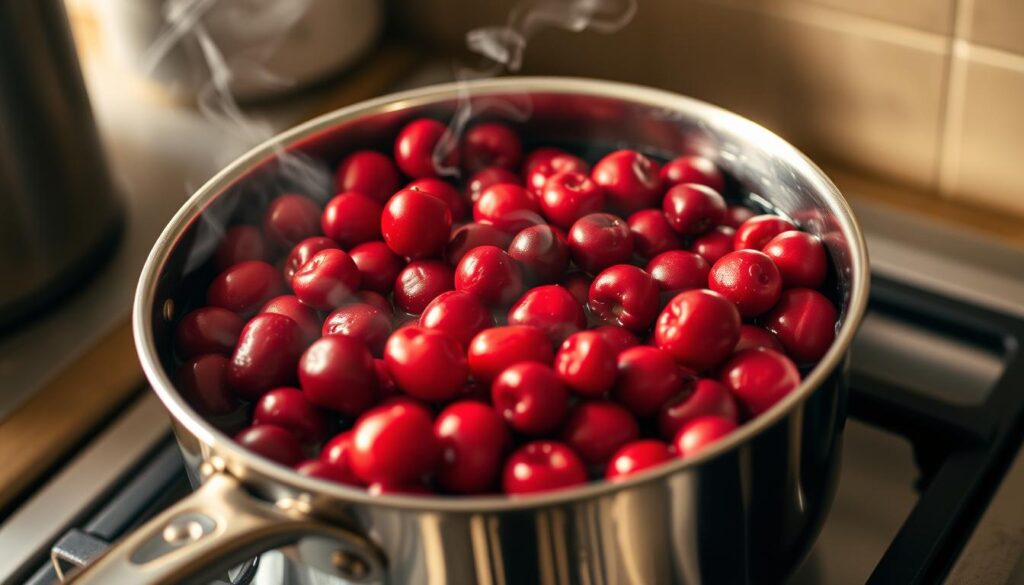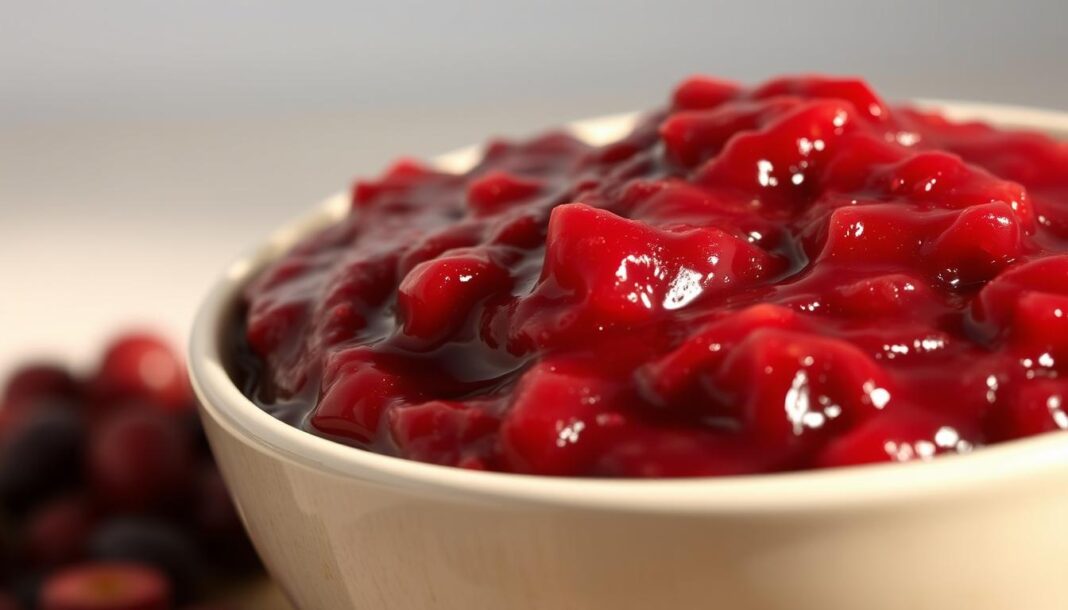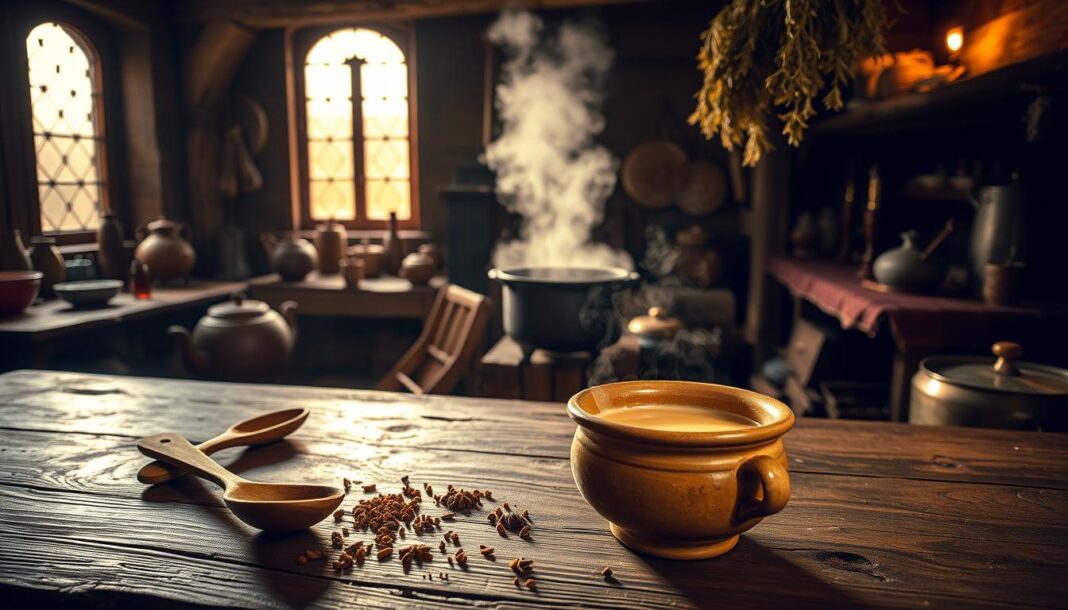Cranberries are a nutrient-rich fruit, loaded with antioxidants and offering numerous health benefits.
We have perfected a technique for preparing fresh cranberries that brings out their natural flavor and texture. Our method involves cooking cranberries on the stove, allowing for precise control over the cooking process.
Cranberries are not just a seasonal fruit; they’re a versatile ingredient that can be used in a variety of dishes, from traditional cranberry sauce to innovative savory recipes.
Key Takeaways
- Our tried-and-tested method for cooking cranberries on the stove.
- The benefits of using the stovetop for superior texture and flavor control.
- Versatile applications of stovetop cranberry preparations.
- The seasonal significance of cranberries during fall and winter holidays.
- Achieving the perfect balance of tartness and sweetness in your cranberry sauce.
The Versatility and Benefits of Fresh Cranberries
The benefits of fresh cranberries extend far beyond their role in holiday cooking, providing a boost to overall health. We appreciate fresh cranberries for their unique flavor and numerous health benefits, making them a great addition to various dishes.
Nutritional Value of Cranberries
Cranberries are rich in antioxidants, containing five times more than broccoli. These compounds contribute significantly to urinary tract health, immune function, and cardiovascular benefits. Cranberries can help prevent urinary tract infections, boost your immune system, and improve circulation. The flavonoids present in cranberries can also help lower bad cholesterol levels.
| Nutrient | Value per Cup | Health Benefit |
|---|---|---|
| Antioxidants | High | Urinary tract health, immune function |
| Flavonoids | Significant | Lower bad cholesterol |
| Fiber | Moderate | Digestive health |
Seasonal Availability and Storage Tips
Fresh cranberries are typically available from September through January. To keep them fresh for up to two months, store them in a tightly sealed package in the refrigerator. For longer storage, freezing is an option, allowing you to keep them for up to a year without significant quality loss. When selecting fresh cranberries, choose those that are firm, have a bright color, and bounce when dropped.

Essential Ingredients for Cooking Cranberries on the Stove
Let’s dive into the essential ingredients needed for cooking cranberries on the stove. The right ingredients not only ensure a delicious flavor but also the perfect texture.
Basic Cranberry Sauce Components
The basic ingredients for our stovetop cranberry sauce include a 12 oz. bag of fresh cranberries, 1/2 cup water, and 1/4 cup sugar. The ratio of these ingredients is crucial for achieving the optimal balance of flavor and texture.
- Fresh cranberries provide the base flavor and texture.
- Water helps to cook the cranberries and achieve the desired consistency.
- Sugar balances the tartness of the cranberries.
Optional Flavor Enhancers
To give your cranberry sauce an extra boost, consider adding some optional flavor enhancers.
Citrus Additions
Adding citrus elements like orange juice or zest can complement the natural tartness of cranberries and add brightness to the sauce.
Spices and Sweeteners
Cinnamon sticks or other warming spices can enhance the seasonal appeal of your cranberry preparations. You can also experiment with different types of sugar or sweeteners like honey or maple syrup to vary the flavor profile.

Our Step-by-Step Method for Cooking Cranberries on the Stove
Cooking cranberries on the stove is a straightforward process when you follow our detailed guide. We will walk you through each step, ensuring you achieve the perfect cranberry sauce every time.
Preparing Fresh Cranberries
The first step in cooking cranberries is to prepare them properly. We start by sorting through the berries and discarding any that are soft or spoiled. This ensures that only the freshest cranberries are used, which is crucial for the best flavor and texture. After sorting, we wash the berries under cold running water to remove any impurities. This simple step helps maintain the natural flavor and cleanliness of the cranberries.

Combining Ingredients in the Saucepan
Next, we combine the prepared cranberries with sugar and water in a saucepan. The ratio of cranberries to sugar can be adjusted based on personal taste preferences, but a general starting point is equal parts cranberries and sugar. We stir these ingredients together gently before applying heat. The order of combining ingredients is crucial as it prevents scorching and ensures even cooking.
Simmering and Cooking Process
We then place the saucepan over medium heat and bring the mixture to a boil. Once boiling, we reduce the heat slightly and let it simmer uncovered for about 4-5 minutes, stirring occasionally. During this time, the mixture will become foamy, and you’ll hear the characteristic “popping” sound as the cranberries release their natural pectins.
How to Tell When Cranberries Are Perfectly Cooked
The cranberries are perfectly cooked when the popping sound has stopped, and the mixture has thickened slightly. It’s essential to remember that the cranberry sauce will continue to thicken as it cools. Therefore, it’s better to err on the side of undercooking slightly rather than overcooking. The total cooking time should be around 4-5 minutes, but always check for the visual cues and adjust the cooking time as needed.
Adjusting Sweetness and Consistency
Customizing the sweetness and consistency of cranberry sauce can elevate it from a simple condiment to a culinary highlight. At Historical Foods, we understand that personal taste plays a significant role in enjoying this traditional sauce.
Sugar Ratios for Different Taste Preferences
The amount of sugar used in cranberry sauce can significantly alter its flavor profile. For a more tart cranberry sauce, we recommend using 1/2 cup of sugar per 12oz of cranberries. Conversely, for a sweeter sauce, 1 cup of sugar per 12oz of cranberries is ideal. This flexibility allows you to tailor the sauce to your taste preferences or to balance it with other dishes you’re serving.
| Sugar Amount | Taste Profile | Sugar per 12oz Cranberries |
|---|---|---|
| Less Sugar | Tart | 1/2 cup |
| More Sugar | Sweet | 1 cup |
Techniques for Thickening or Thinning Your Sauce
The consistency of cranberry sauce is another crucial aspect of its preparation. The sauce will naturally thicken as it cools due to the pectins released during cooking. If your sauce is too thick, you can thin it with small amounts of water, juice, or liqueur. Conversely, if it’s too loose, additional cooking or cooling will help achieve the desired consistency and texture.
By adjusting the sweetness and consistency, you can create a cranberry sauce that perfectly complements your meal. Whether you prefer it tart or sweet, thick or thin, the flexibility of cranberry sauce makes it a versatile condiment for any occasion.
Flavor Variations for Stovetop Cranberry Recipes
We’re excited to share our favorite ways to enhance the flavor of stovetop cranberries, from classic combinations to innovative twists. By incorporating different ingredients and techniques, you can create a cranberry sauce that perfectly complements your holiday meal.
Classic Orange Cranberry Sauce
One of the most timeless and beloved cranberry sauce variations is the classic orange cranberry sauce. To make this, squeeze the juice from orange slices and add the peels into the pot while cooking. The bright acidity and subtle sweetness of oranges enhance the cranberries’ natural flavor without overwhelming it. This combination creates a deliciously balanced flavor profile that’s sure to please.
The orange zest adds a nice depth to the sauce, while the juice provides a nice acidity. You can adjust the amount of orange juice to your taste, depending on how strong you like the orange flavor.
Cinnamon and Spice Infusions
Cinnamon and spice infusions are another great way to add warmth and depth to your cranberry sauce. To infuse your cranberry sauce with cinnamon, add 4 cinnamon sticks to the mixture while cooking, then remove them before serving. This technique allows you to incorporate the warm, comforting flavor of cinnamon without any textural interference.
Other spices like nutmeg and cloves can also be used to create a unique and aromatic flavor profile. Experiment with different spice combinations to find the one that you enjoy the most.
Creative Mix-ins for Unique Flavor Profiles
For those looking to get creative, there are countless mix-ins you can add to your cranberry sauce to give it a unique twist. Some of our favorites include ginger, star anise, vanilla, port wine, and even jalapeño for a sweet-heat combination. When adding mix-ins, be sure to adjust the cooking time and consistency accordingly.
| Mix-in | Flavor Profile | Cooking Time Adjustment |
|---|---|---|
| Ginger | Spicy, warm | Reduce cooking time by 5 minutes |
| Star Anise | Sweet, licorice-like | No adjustment needed |
| Jalapeño | Spicy, sweet | Reduce cooking time by 3 minutes |
By understanding the principles of flavor pairing and experimenting with different ingredients, you can create your own signature cranberry sauce that’s sure to impress. Don’t be afraid to try new combinations and adjust techniques to ensure perfect results.
Alternative Stovetop Cooking Methods for Cranberries
The stovetop offers a range of possibilities for cooking cranberries, from savory preparations to sweet compotes and beyond. We explore these alternative methods to unlock the full potential of cranberries in various recipes.
Savory Cranberry Preparations
Savory cranberry dishes can add a delightful twist to your meals. By incorporating cranberries into chutneys, relishes, and savory compotes, you can create condiments that pair beautifully with proteins like poultry, pork, and game. To make a savory cranberry sauce, we suggest reducing the amount of sugar and adding ingredients like onions, garlic, and spices to create a flavor profile that complements your main course.
- Add cranberries to roasted vegetables like Brussels sprouts or sweet potatoes for a burst of flavor.
- Use cranberry chutney as a glaze for meats or as a side dish.
- Mix cooked cranberries with savory grains like quinoa or farro for added flavor.
Cranberry Compotes and Fruit Mixtures
Cranberries can also be combined with other fruits to create delicious compotes. Apples, pears, and quince are excellent choices to mix with cranberries, offering varying levels of sweetness and texture. When creating a cranberry compote, adjust the cooking time and liquid ratio based on the fruits you combine. For instance, apples and cranberries cook relatively quickly, while quince may require longer cooking times due to its firm texture.
These compotes can be used as fillings for pies and crisps or served as a side dish. Experimenting with different fruit combinations will help you discover unique flavor profiles that can elevate your desserts and savory dishes alike.
Storing and Serving Your Stovetop Cranberries
Having successfully cooked your cranberries, we’ll guide you through the process of storing and creatively serving your cranberry sauce. Proper storage is crucial for maintaining the quality of your cranberry sauce. We recommend cooling it completely before transferring it to airtight containers to prevent moisture buildup.
Your freshly made cranberry sauce can be stored in the fridge for 7-10 days. For longer storage, consider freezing it, as it can last up to 1 month in the fridge is not correct here, it should be freezer. The flavor of your cranberry sauce often improves after a day of refrigeration, making it an ideal make-ahead component for holiday meals.
Beyond the traditional pairing with turkey, cranberry sauce can elevate various dishes. Try using it as a topping for baked brie, a glaze for roasted meats, or a spread for sandwiches. You can also add it to breakfast dishes for a burst of flavor. When you’re ready to serve, you can revitalize stored cranberry sauce by adjusting its consistency and brightening its flavors as needed.
By following these storage and serving tips, you can enjoy your homemade cranberry sauce throughout the holiday season and beyond, making your recipe a new favorite.


